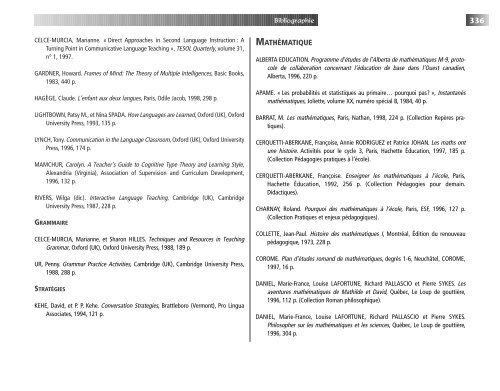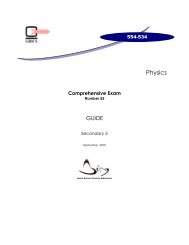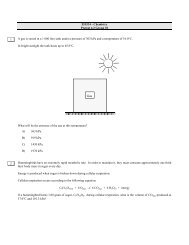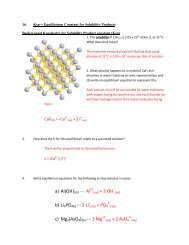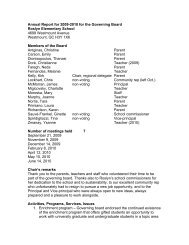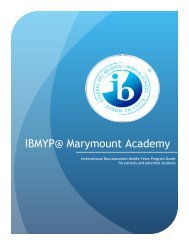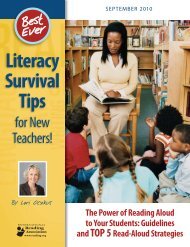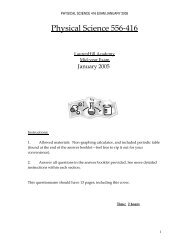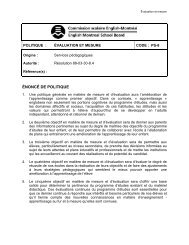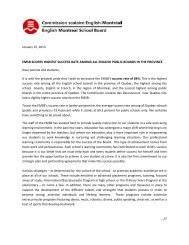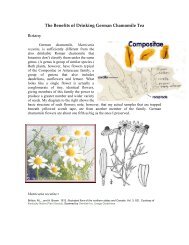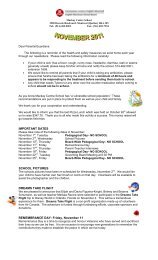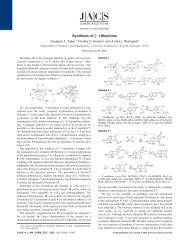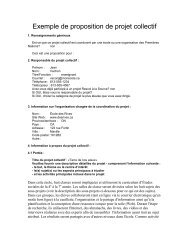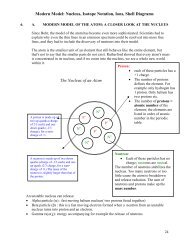JOLIBERT, Josette, Catherine CRÉPON et le Groupe <strong>de</strong> recherche d’Écouen. Former <strong>de</strong>s enfants lecteurs <strong>de</strong> textes,Paris, Hachette Écoles, 1991, 95 p. JORRO, Anne. Le lecteur interprète,Paris, P.U.F. 1999, 136 p. MORAIS, José. L’art <strong>de</strong> lire,Paris, Odile Jacob, 1999, 359 p. OBSERVATOIRE NATIONAL DE LA LECTURE. Apprendre à lire, Paris, Odile Jacob, 1998, 219 p. PIGALLET, Philippe. Métho<strong>de</strong>s et stratégies <strong>de</strong> lecture, Paris, ESF, 1996, 168 p. SAVINO, Josiane, et Jean AGNÈS. Apprendre avec la presse, Paris, Retz, Pédagogie pratique, 1999, 256 p. VAN GRUNDERBEECK, Nicole. Les difficultés en lecture, Boucherville, Gaëtan Morin, 1994, 159 p. VANDERDORPE, Christian. Du papyrus à l’hypertexte, Cap-Saint-Ignace, Boréal, 1999, 271 p. VANDERDORPE, Christian. Apprendre à lire <strong>de</strong>s fables, Longueuil, le Préambule, 1989, 191 p. FRANÇAIS,ACCUEIL CURRICULUM ACPL Curriculum multidimensionnel : Communicatif expérientiel, culture, <strong>formation</strong> langagière générale, langue, sous la direction <strong>de</strong> Raymond LeBlanc, M Éditeur, 1990. ASTOLFI, Jean-Pierre. L’erreur, un outil pour enseigner,Paris, ESF, 1997, 117 p. (Collection Pratiques et enjeux pédagogiques). CANDLIN, C.N., et D. F. MURPHY. Language Learning Tasks in English Language Education, London (UK), Prentice Hall, vol. 7, 1987, 172 p. GERMAIN Clau<strong>de</strong>, et Hubert SÉGUIN. Le point sur... La grammaire en didactique <strong>de</strong>s langues, Montréal, CEC, 1995, 227 p. GERMAIN, Clau<strong>de</strong>. Évolution <strong>de</strong> l’enseignement <strong>de</strong>s langues : 5 000 ans d’histoire, Montréal, CLE international, Hurtubise HMH, 1993, 351 p. GERMAIN, Clau<strong>de</strong>. Le point sur... L’approche communicative en didactique <strong>de</strong>s langues, Montréal, CEC, 1991, 103 p. MONNERIE, Annie. Le français au présent, français langue étrangère,Paris, Didier/Hatier, 1987, 213 p. PARROT, Martin. Tasks for Language Teachers, Melbourne, Cambridge University Press, 1993, 325 p. PIRON Valérie, et Joseph TONNEAU. Construire son savoir-lire, savoir-écrire, Belgique, Érasme, 1990, 458 p. WENDEN, Anita. Learner Strategies for Learner Autonomy, Cambridge, Prentice Hall International, 1991, 172 p. ANGLAIS, LANGUE SECONDE GÉNÉRAL ABRAMI, Philip C., et autres. Using Cooperative Learning, Montréal, Concordia University, 1993, 294 p. ARMSTRONG, Thomas. Multiple Intelligences in the Classroom, Alexandria (Virginia), Association of Supervision and Curriculum Development, 1994, 185 p. CANALE, M., et M. SWAIN. Theoretical Bases of Communicative Approaches to Second Language Teaching and Testing,Toronto, Centre <strong>de</strong> recherches franco-ontariennes, Institut d’étu<strong>de</strong>s pédagogiques <strong>de</strong> l’Ontario, Applied Linguistics, 1980, p. 1-47. Bibliographie 335
Bibliographie 336 CELCE-MURCIA, Marianne. « Direct Approaches in Second Language Instruction : A Turning Point in Communicative Language Teaching », TESOL Quarterly, volume 31, n° 1, 1997. GARDNER, Howard. Frames of Mind: The Theory of Multiple Intelligences, Basic Books, 1983, 440 p. HAGÈGE, Clau<strong>de</strong>. L’enfant aux <strong>de</strong>ux langues,Paris, Odile Jacob, 1998, 298 p. LIGHTBOWN, Patsy M., et Nina SPADA. How Languages are Learned, Oxford (UK), Oxford University Press, 1993, 135 p. LYNCH,Tony. Communication in the Language Classroom, Oxford (UK), Oxford University Press, 1996, 174 p. MAMCHUR, Carolyn. A Teacher’s Gui<strong>de</strong> to Cognitive Type Theory and Learning Style, Alexandria (Virginia), Association of Supervision and Curriculum Development, 1996, 132 p. RIVERS, Wilga (dir.). Interactive Language Teaching, Cambridge (UK), Cambridge University Press, 1987, 228 p. GRAMMAIRE CELCE-MURCIA, Marianne, et Sharon HILLES. Techniques and Resources in Teaching Grammar,Oxford (UK), Oxford University Press, 1988, 189 p. UR, Penny. Grammar Practice Activities, Cambridge (UK), Cambridge University Press, 1988, 288 p. STRATÉGIES KEHE, David, et P. P. Kehe. Conversation Strategies, Brattleboro (Vermont), Pro Lingua Associates, 1994, 121 p. MATHÉMATIQUE ALBERTA EDUCATION. <strong>Programme</strong> d’étu<strong>de</strong>s <strong>de</strong> l’Alberta <strong>de</strong> mathématiques M-9, protocole <strong>de</strong> collaboration concernant l’éducation <strong>de</strong> base dans l’Ouest canadien, Alberta, 1996, 220 p. APAME. « Les probabilités et statistiques au primaire… pourquoi pas? », Instantanés mathématiques, Joliette, volume XX, numéro spécial B, 1984, 40 p. BARRAT, M. Les mathématiques, Paris, Nathan, 1998, 224 p. (Collection Repères pratiques). CERQUETTI-ABERKANE, Françoise, Annie RODRIGUEZ et Patrice JOHAN. Les maths ont une histoire. Activités pour le cycle 3, Paris, Hachette Éducation, 1997, 185 p. (Collection Pédagogies pratiques à l’école). CERQUETTI-ABERKANE, Françoise. Enseigner les mathématiques à l’école, Paris, Hachette Éducation, 1992, 256 p. (Collection Pédagogies pour <strong>de</strong>main. Didactiques). CHARNAY, Roland. Pourquoi <strong>de</strong>s mathématiques à l’école, Paris, ESF, 1996, 127 p. (Collection Pratiques et enjeux pédagogiques). COLLETTE, Jean-Paul. Histoire <strong>de</strong>s mathématiques I, Montréal, Édition du renouveau pédagogique, 1973, 228 p. COROME. Plan d’étu<strong>de</strong>s romand <strong>de</strong> mathématiques, <strong>de</strong>grés 1-6, Neuchâtel, COROME, 1997, 16 p. DANIEL, Marie-France, Louise LAFORTUNE, Richard PALLASCIO et Pierre SYKES. Les aventures mathématiques <strong>de</strong> Mathil<strong>de</strong> et David, Québec, Le Loup <strong>de</strong> gouttière, 1996, 112 p. (Collection Roman philosophique). DANIEL, Marie-France, Louise LAFORTUNE, Richard PALLASCIO et Pierre SYKES. Philosopher sur les mathématiques et les sciences, Québec, Le Loup <strong>de</strong> gouttière, 1996, 304 p.
- Page 2 and 3:
Programme de formation de l’écol
- Page 4 and 5:
Au personnel enseignant de l’édu
- Page 6 and 7:
Chapitre 1 Photo: Alain Désilets P
- Page 8 and 9:
équitable. Sa toute première resp
- Page 10 and 11:
Par savoir-agir, on entend la capac
- Page 12 and 13:
familial, en premier lieu, marquent
- Page 14 and 15:
1.8 LES ÉLÉMENTS CONSTITUTIFS DES
- Page 16 and 17:
Chapitre 2 Compétences transversal
- Page 18 and 19:
Le Programme de formation retient n
- Page 20 and 21:
COMPÉTENCE 1 • EXPLOITER L’INF
- Page 22 and 23:
COMPÉTENCE 2 • RÉSOUDRE DES PRO
- Page 24 and 25:
COMPÉTENCE 3 • EXERCER SON JUGEM
- Page 26 and 27:
COMPÉTENCE 4 • METTRE EN ŒUVRE
- Page 28 and 29:
Les compétences d’ordre méthodo
- Page 30 and 31:
Composantes de la compétence Analy
- Page 32 and 33:
Composantes de la compétence S’a
- Page 34 and 35:
Compétences transversales Compéte
- Page 36 and 37:
Compétences transversales Compéte
- Page 38 and 39:
Compétences transversales Compéte
- Page 40 and 41:
COMPÉTENCE 9 • COMMUNIQUER DE FA
- Page 42 and 43:
Photo: Alain Désilets Santé et bi
- Page 44 and 45:
Schéma 3 Domaines généraux de fo
- Page 46 and 47:
ORIENTATION ET ENTREPRENEURIAT Bien
- Page 48 and 49:
Faire le partage entre ses besoins
- Page 50 and 51:
INTENTION ÉDUCATIVE Développer ch
- Page 52 and 53:
Chapitre 4 Éducation préscolaire
- Page 54 and 55:
Les enfants inscrits pour la premi
- Page 56 and 57:
Composantes de la compétence Crit
- Page 58 and 59:
Composantes de la compétence Crit
- Page 60 and 61:
Composantes de la compétence S’i
- Page 62 and 63:
Composantes de la compétence Démo
- Page 64 and 65:
Composantes de la compétence Démo
- Page 66 and 67:
Composantes de la compétence Crit
- Page 68 and 69:
STRATÉGIES (SUITE) - Comparer. - S
- Page 70 and 71:
Chapitre 5 Domaine des langues 69
- Page 72 and 73:
Photo: Alain Désilets Domaine des
- Page 74 and 75:
évidence le rayonnement de la lang
- Page 76 and 77:
Composantes de la compétence Const
- Page 78 and 79:
Plus l’élève devient conscient
- Page 80 and 81:
Attentes de fin de cycle PREMIER CY
- Page 82 and 83:
LIENS AVEC LES COMPÉTENCES TRANSVE
- Page 84 and 85:
Attentes de fin de cycle PREMIER CY
- Page 86 and 87:
Composantes de la compétence Crit
- Page 88 and 89:
TEXTES LITTÉRAIRES ET COURANTS (FO
- Page 90 and 91:
CONNAISSANCES LIÉES AU TEXTE (SUIT
- Page 92 and 93:
STRATÉGIES STRATÉGIES DE LECTURE
- Page 94 and 95:
STRATÉGIES DE COMMUNICATION ORALE
- Page 96 and 97:
TECHNIQUES • Apprentissage de la
- Page 98 and 99:
Domaine des langues English as a Se
- Page 100 and 101:
Domaine des langues English as a Se
- Page 102 and 103:
Domaine des langues English as a Se
- Page 104 and 105:
Domaine des langues English as a Se
- Page 106 and 107:
Domaine des langues English as a Se
- Page 108 and 109:
Domaine des langues English as a Se
- Page 110 and 111:
Domaine des langues Français, accu
- Page 112 and 113:
Domaine des langues Français, accu
- Page 114 and 115:
Domaine des langues Français, accu
- Page 116 and 117:
Domaine des langues Français, accu
- Page 118 and 119:
Domaine des langues Français, accu
- Page 120 and 121:
Domaine des langues Français, accu
- Page 122 and 123:
122 Chapitre 6 Domaine de la mathé
- Page 124 and 125:
Domaine de la mathématique, de la
- Page 126 and 127:
Domaine de la mathématique, de la
- Page 128 and 129:
Domaine de la mathématique, de la
- Page 130 and 131:
Domaine de la mathématique, de la
- Page 132 and 133:
Domaine de la mathématique, de la
- Page 134 and 135:
Domaine de la mathématique, de la
- Page 136 and 137:
Domaine de la mathématique, de la
- Page 138 and 139:
Domaine de la mathématique, de la
- Page 140 and 141:
Domaine de la mathématique, de la
- Page 142 and 143:
Domaine de la mathématique, de la
- Page 144 and 145:
Domaine de la mathématique, de la
- Page 146 and 147:
Domaine de la mathématique, de la
- Page 148 and 149:
Savoirs essentiels Les savoirs esse
- Page 150 and 151:
Composantes de la compétence Éval
- Page 152 and 153:
Composantes de la compétence Éval
- Page 154 and 155:
Composantes de la compétence S’a
- Page 156 and 157:
Savoirs essentiels Les savoirs esse
- Page 158 and 159:
LA TERRE ET L’ESPACE (SUITE) •
- Page 160 and 161:
STRATÉGIES (SUITE) - Explorer dive
- Page 162 and 163:
Chapitre 7 Domaine de l’univers s
- Page 164 and 165:
Composantes de la compétence Crit
- Page 166 and 167:
Photo: Alain Désilets Domaine de l
- Page 168 and 169:
Le développement de ces trois comp
- Page 170 and 171:
Composantes de la compétence Étab
- Page 172 and 173:
Composantes de la compétence Atten
- Page 174 and 175:
Composantes de la compétence Justi
- Page 176 and 177:
GRILLES D’ÉTUDE DE DIFFÉRENTES
- Page 178 and 179:
LA SOCIÉTÉ IROQUOIENNE VERS 1500
- Page 180 and 181:
LA SOCIÉTÉ CANADIENNE VERS 1820 (
- Page 182 and 183:
LA SOCIÉTÉ FRANCAISE ET LA SOCIÉ
- Page 184 and 185:
DÉMARCHE DE RECHERCHE ET DE TRAITE
- Page 186 and 187:
190 Chapitre 8 Ces disciplines perm
- Page 188 and 189:
Domaine des arts 192 Savoirs essent
- Page 190 and 191:
Domaine des arts 8.1 Art dramatique
- Page 192 and 193:
chomotrices complexes, ce qui impos
- Page 194 and 195:
Composantes de la compétence Explo
- Page 196 and 197:
Composantes de la compétence S’a
- Page 198 and 199:
Composantes de la compétence Exami
- Page 200 and 201:
TECHNIQUES DE JEU (SUITE) - Rythme
- Page 202 and 203:
VOCABULAIRE action dramatique aire
- Page 204 and 205:
Domaine des arts Arts plastiques 21
- Page 206 and 207:
Domaine des arts Arts plastiques 21
- Page 208 and 209:
Domaine des arts Arts plastiques 21
- Page 210 and 211:
Domaine des arts Arts plastiques 21
- Page 212 and 213:
Domaine des arts Arts plastiques 21
- Page 214 and 215:
Domaine des arts Arts plastiques 22
- Page 216 and 217:
Photo: L’Imagier Domaine des arts
- Page 218 and 219:
De son côté, la compétence 3 est
- Page 220 and 221:
Composantes de la compétence Crit
- Page 222 and 223:
Composantes de la compétence Crit
- Page 224 and 225:
Composantes de la compétence Exami
- Page 226 and 227:
ESPACE • Espace personnel Niveaux
- Page 228 and 229:
RÈGLES RELATIVES AUX MOUVEMENTS D
- Page 230 and 231:
Domaine des arts Photo: François N
- Page 232 and 233:
premières compétences et met en v
- Page 234 and 235:
Composantes de la compétence Explo
- Page 236 and 237:
Composantes de la compétence Crit
- Page 238 and 239:
Composantes de la compétence Exami
- Page 240 and 241:
REPRÉSENTATION GRAPHIQUE (SUITE) -
- Page 242 and 243:
STRUCTURES (SUITE) • Tempo - Lent
- Page 244 and 245:
Chapitre 9 Développement personnel
- Page 246 and 247:
APPRENTISSAGES COMMUNS AU DOMAINE D
- Page 248 and 249:
Développement personnel Éducation
- Page 250 and 251:
Développement personnel Éducation
- Page 252 and 253:
Développement personnel Éducation
- Page 254 and 255:
Développement personnel Éducation
- Page 256 and 257:
Développement personnel Éducation
- Page 258 and 259:
Développement personnel Éducation
- Page 260 and 261:
Développement personnel Éducation
- Page 262 and 263:
Photo: Alain Désilets Développeme
- Page 264 and 265:
à comprendre ce qu’il vit pour
- Page 266 and 267:
Compétence 1 • COMPRENDRE DES SI
- Page 268 and 269:
Attentes de fin de cycle PREMIER CY
- Page 270 and 271:
Établir des relations entre ce qu
- Page 272 and 273:
Établir des relations entre son mi
- Page 274 and 275: Composantes de la compétence Expli
- Page 276 and 277: STRATÉGIES ET CONNAISSANCES UTILES
- Page 278 and 279: Composantes de la compétence Crit
- Page 280 and 281: CONNAISSANCES ET STRATÉGIES UTILES
- Page 282 and 283: Photo: François Nadeau Développem
- Page 284 and 285: L’enseignement moral et religieux
- Page 286 and 287: Composantes de la compétence Explo
- Page 288 and 289: Composantes de la compétence Crit
- Page 290 and 291: DÉVELOPPEMENT PERSONNEL (SUITE)
- Page 292 and 293: DÉVELOPPEMENT SOCIORELATIONNEL (SU
- Page 294 and 295: DÉVELOPPEMENT SOCIORELATIONNEL (SU
- Page 296 and 297: GRANDES QUESTIONS HUMAINES (SUITE)
- Page 298 and 299: STRATÉGIES POUR PRENDRE POSITION D
- Page 300 and 301: Développement personnel Enseigneme
- Page 302 and 303: Développement personnel Enseigneme
- Page 304 and 305: Savoirs essentiels Développement p
- Page 306 and 307: Développement personnel Enseigneme
- Page 308 and 309: Développement personnel Enseigneme
- Page 310 and 311: Savoirs essentiels Développement p
- Page 312 and 313: Développement personnel Enseigneme
- Page 314 and 315: Savoirs essentiels Développement p
- Page 316 and 317: Bibliographie 327
- Page 318 and 319: REY, Bernard. Les compétences tran
- Page 320 and 321: PIAGET, Jean. La représentation du
- Page 322 and 323: DUFAYS, Jean-Louis, Louis GEMENNE e
- Page 326 and 327: DEBLOIS, Lucie. « La numération d
- Page 328 and 329: DEFOY, Gilles. L’activité à car
- Page 330 and 331: LAVILLE, Christian. « L’épisté
- Page 332 and 333: ARTS PLASTIQUES ARNHEIM, Rudolf. La
- Page 334 and 335: REIMER, Bennet. Une philosophie de
- Page 336 and 337: CONSEIL SUPÉRIEUR DE L’ÉDUCATIO
- Page 338 and 339: Bonne nouvelle pour toi! La Bible e
- Page 340 and 341: Notes
- Page 342: 13-0003-07 Photo: Alain Désilets M


